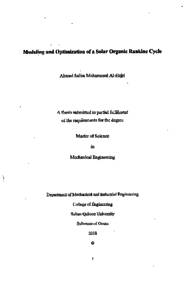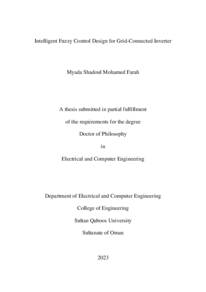Document
Modeling and optimization of a solar organic rankine cycle
Publisher
Sultan Qaboos University
Gregorian
2018
Language
English
English abstract
Organic Rankine Cycle is one of the imperative techniques in generating electricity using the thermodynamic properties of the refrigerants. It doesn't differ from the steam Rankine cycle in principle except in the working fluid. It comes to overcome some of the disadvantages of using the steam Rankine cycle, such as operating the cycle in low- • grade heat sources like solar energy and industrial heat waste. The type of fluids that circulate in the ORCs are organic fluids which due to their specific characteristics are suitable for low grade heat applications.
This work investigates the optimal working fluid for the ORC by concentrating on the thermo-dynamic' properties and safety and environmental aspects. A solar radiation was utilized as the heat source using vacuum tube solar collector. The collector was modeled mathematically and the governing equation was used to obtain the average temperature in the cities of study. Eighteen working fluids were studied using a MatLab code. Nonlinear correlations were used using the thermodynamic properties database provided by REFPROP9.1 using the dimensionless factor = 1 - sat. The maximum error in using these correlations is not exceeding 4%. In this study, three simulation scenarios were investigated for the three types of fluids. Two cases were considered in each scenario: inspecting the properties at 1000 kPa as an evaporator pressure and finding the optimal pressure for the fluids using the pinch temperature. The Pinch temperature should not exceed 10 K. Wet fluids have lower NBP than dry and isentropic fluids. The heat source is enough to vaporize the wet fluids due to the low NBP. Whereas, some of the dry and isentropic fluids may require more heat source to operate an ORC . That can be explained by, their saturation temperature is higher than the heat source, so the pinch temperature limitation cannot be achieved. The best working fluids in each scenario were nominated to a safety and environment comparison. The simulation were carried out for a range of an evaporator pressure and for four different condensing pressures. Lowering the condenser pressure will results in increasing the work output, consequently the thermal efficiency. Determining the optimal working fluids is not an easy process, since there are many criteria to deal with. These criteria has to be checked thermodynamically in one side and environmentally from the other side .A high evaporator pressure needs a high cost and complicated equipment, therefore increasing the cost of the system. On the other hand, decreasing the condensing pressure involves an air infiltration, which will require a special vacuum equipment to reject air from the cycle.
Member of
Resource URL
Arabic abstract
دورة رانكين هي الدورة الحرارية المستخدمة في التوربينات الحرارية لإنتاج الطاقة الحركية التي تستخدم فيما بعد الإنتاج الطاقة الكهربائية عن طريق استخدام المولدات الكهربائية. دورة رانكين العادية تستخدم الماء للتشغيل بينما دورة رانكين الحرارية العضوية تستخدم السوائل العضوية بسبب خصائصها الحرارية التي تمكنها من الاستفادة من مصادر الطاقة ذات الحرارة المنخفضة نسبيا كالطاقة الشمسية ومخلفات الحرارة من المصانع وما شابه ذلك؛ لهذا السبب اصبح استخدام دورة رانكين العضوية شائعا مؤخرا لاعتمادها على مصادر الحرارة المنخفضة. يمثل اختيار السائل المناسب لدورة رانكين العضوية أهمية كبرى؛ لأن الخصائص الحرارية لكل سائل تختلف عن الأخر وكذلك تختلف إنتاجية كل سائل عضوي للطاقة المستخرجة باختلاف الضغط والحرارة المسلطان على المبادل الحراري (المبخر).
في هذه الدراسة، تم فحص جميع السوائل العضوية لاختيار أفضلها عن طريق التركيز على الخصائص الحرارية والبيئية لكل سائل عضوي. حيث تم في المرحلة الأولى من الدراسة، دراسة استغلال الإشعاع الشمسي الساقط على أنابيب تجميع الطاقة الشمسية والتي بدورها تنقل الطاقة الحرارية إلى الماء المستخدم في تبخير السوائل العضوية عن طريق التبادل الحراري في مبخر دورة رانكين العضوية باستخدام المعادلات الرياضية التي تم اشتقاقها من التحليل الرياضي لأنابيب تجميع الطاقة الشمسية. في المرحلة الثانية من الدراسة تم نمذجة دورة رانكين العضوية وذلك بالوقوف عند كل جزء من أجزاءها واشتقاق المعادلات المتعلقة بها وبالتالي حساب الخصائص الحرارية على أي مستوى للضغط أو الحرارة باستخدام معادلات عامة للخصائص الحرارية لثمانية عشر سائل عضوي من دراسة أخرى عن طريق برنامج الحساب الهندسي ماتلاب. حيث إن السوائل العضوية تصنف حسب شكل الرسم البياني لخصائص السائل الحرارية الى ثلاثة أنواع؛ وهي السائل الجاف والسائل الرطب والسائل المتعادل.
في القسم الثاني من البحث؛ تم إيجاد وضعية العمل الأفضل لكل سائل وذلك باختيار الضغط المناسب لكل سائل ومن ثم تحليل الفعالية الحرارية لكل منها وذلك عن طريق استخدام التحليل الحراري للمبخر والحصول على أفضل ضغط يمكن استخدامه لكل سائل. السوائل التي حصلت على أفضل إنتاجية للطاقة وفعالية حرارية؛ تم مقارنتها حسب خصائص السلامة والبيئة المعدة من قبل الجمعية الأمريكية لمهندسي التبريد والتدفئة وتكييف الهواء (ASHRAE) ، وخصائص التوصيل الحراري واللزوجة ومن ثم اختيار السائل الأفضل. كل العلاقات الرياضية لكل السوائل مع اختلاف الضغوطات تم رسمها في رسوم بيانية توضيحية لتساعد على دراسة العلاقات بشكل افضل. كنتيجة من هذه الدراسة لا يوجد سائل تتوفر فيه كافة المواصفات الجيدة التي تمكننا من استخدامه المحركات رانكين العضوية.
في هذه الدراسة، تم فحص جميع السوائل العضوية لاختيار أفضلها عن طريق التركيز على الخصائص الحرارية والبيئية لكل سائل عضوي. حيث تم في المرحلة الأولى من الدراسة، دراسة استغلال الإشعاع الشمسي الساقط على أنابيب تجميع الطاقة الشمسية والتي بدورها تنقل الطاقة الحرارية إلى الماء المستخدم في تبخير السوائل العضوية عن طريق التبادل الحراري في مبخر دورة رانكين العضوية باستخدام المعادلات الرياضية التي تم اشتقاقها من التحليل الرياضي لأنابيب تجميع الطاقة الشمسية. في المرحلة الثانية من الدراسة تم نمذجة دورة رانكين العضوية وذلك بالوقوف عند كل جزء من أجزاءها واشتقاق المعادلات المتعلقة بها وبالتالي حساب الخصائص الحرارية على أي مستوى للضغط أو الحرارة باستخدام معادلات عامة للخصائص الحرارية لثمانية عشر سائل عضوي من دراسة أخرى عن طريق برنامج الحساب الهندسي ماتلاب. حيث إن السوائل العضوية تصنف حسب شكل الرسم البياني لخصائص السائل الحرارية الى ثلاثة أنواع؛ وهي السائل الجاف والسائل الرطب والسائل المتعادل.
في القسم الثاني من البحث؛ تم إيجاد وضعية العمل الأفضل لكل سائل وذلك باختيار الضغط المناسب لكل سائل ومن ثم تحليل الفعالية الحرارية لكل منها وذلك عن طريق استخدام التحليل الحراري للمبخر والحصول على أفضل ضغط يمكن استخدامه لكل سائل. السوائل التي حصلت على أفضل إنتاجية للطاقة وفعالية حرارية؛ تم مقارنتها حسب خصائص السلامة والبيئة المعدة من قبل الجمعية الأمريكية لمهندسي التبريد والتدفئة وتكييف الهواء (ASHRAE) ، وخصائص التوصيل الحراري واللزوجة ومن ثم اختيار السائل الأفضل. كل العلاقات الرياضية لكل السوائل مع اختلاف الضغوطات تم رسمها في رسوم بيانية توضيحية لتساعد على دراسة العلاقات بشكل افضل. كنتيجة من هذه الدراسة لا يوجد سائل تتوفر فيه كافة المواصفات الجيدة التي تمكننا من استخدامه المحركات رانكين العضوية.
Category
Theses and Dissertations


